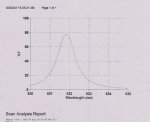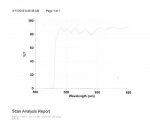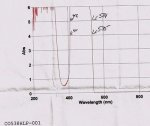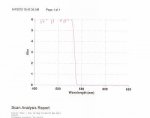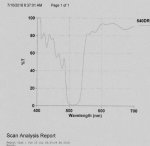To keep this project running i ordered today some new filters for a new assembly at BJOMEJAG ebay that should be a little bit more effective.
Because this parts have a litte bit of delivery time i first selected them and ordered , bevore go on with the other projects.
1. Optical Interference Filter 532SC0.9 24.5mm Ulta-narrow 2nd Harmonic YAG High T%
cleaning up filter, is for isolating, resolving emission from a 2nd Harmonic YAG laser, occuring at 532 nm.
Intended application would be to "clean up" a laser output, or to detect ouput energy of the laser.
Individual filter specifications : CWL 532.0+-0.2nm,
HBW 0.9+- 0.1nm,
Size 24.5mm,
Free Spectral range from 0.8 to 1.2 times the CWL. to.
Unmounted 1.3mm thickness.
2. Optical Filter 535EFLP Laser Block 25mm Green Em Omega
longpassfilter is NOS of OEM, for detecting Green emission of Dyes such as FITC, Spectrum Green, GFP, and many other green dyes.
It could be used with any blue exciter.
Specification : Cut on wavelength 535 +- 3 nm,
Transmission band from 540 nm to 1500 nm,
Blocking band X-ray to 515nm avg >> OD 6,
Size 25+-0.2mm,Thickness 3.0mm, Unmounted.
3. Optical Filter 538AELP 25 mm dia, Laser Block 532 & 535mm Green/Orange Sputtered
longpassfilter is NOS of OEM too, for detecting Green/Orange emission of Dyes such as TRITC, YFP, and many other green dyes. It could be used with any blue or Green exciter. Designed to achieve OD 5+ at 534 nm. Also ideal for Raman signal when excited with 530 to 535nm laser.
This filter is a monolithic Schott Glass substrate with a refractory oxide surface coating.
Specification : Cut on wavelength 535 +- 2 nm,
Transmission band from 540 nm to 1500 nm,
Avg T 540 to 950 > 95%,
Blocking 400 to 535nm avg >> OD 6,
Size 25+-0.2mm,
Thickness 2.0 mm, Unmounted.
4. Optical Filter Barrier 535EFLP 25mm X 1.5mm LED Blocking Window
longpassfilter with slightly other transmission, also for detecting Green/Orange emission of Dyes such as TRITC, YFP, and many other green dyes.
It could also be used with any blue or Green exciter. Designed to achieve OD 5+ at 534 nm.
Also ideal for Raman signal when excited with 530 to 535nm laser.
This filter is a monolithic Schott Glass substrate with a refractory oxide surface coating.
Specification : Cut on wavelength 535 +- 2 nm,
Transmission band from 540 nm to 1500 nm,
Avg T 540 to 950 > 95%,
Blocking 400 to 535nm avg >> OD 6,
Size 25+-0.2mm,
Thickness 2.0 mm, Unmounted.
5. Optical Filter Dichroic 540DRLP 25mm dia X 1mm Beamsplitter @45 R95% @532nm
dichro-beamsplitter from Omega OEMogram. The filter is idea as a Greenier Filter, attenuating the tail of a Cyan or Green LED, while transmitting 95% of the emission from Fluorescence, excited by the LED or Diode Laser.
Filter specs : Cut-on wavelength 535+-2nm,
Attenuating region deep UV to 530 nm to O.D. 6.0,
Transmitting range min 538 to 2000nm,
size 25mm dia x 1.5mm thick, unmounted.




